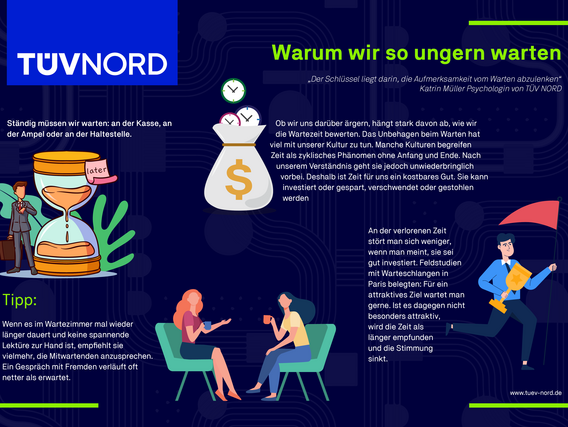Why we don't like to wait
Mobility: For many people, waiting is torture. But it doesn't have to be.

Mobility: For many people, waiting is torture. But it doesn't have to be.

We have to wait all the time: at the checkout, at the traffic lights or at the bus stop. But while we get annoyed if the train is 20 minutes late, at the airport we queue up two hours before departure without grumbling. And in restaurants, we sometimes even get annoyed when things move quickly: waiting together is part of a pleasant meal - we want it that way.
When waiting voluntarily, time seems to pass more quickly, as an experiment in California showed: some of the students who wanted to travel to university by public transport could choose between two alternatives: wait five minutes for a free ride or leave immediately for 75 cents. The time until departure seemed shorter for those who chose to wait than for those who had to stand involuntarily at the stop for just as long.
Whether we are annoyed by this depends very much on how we evaluate the waiting time. “The discomfort of waiting has a lot to do with our culture,” says Katrin Müller from the Medical-Psychological Institute of TÜV NORD in Düsseldorf. Some cultures see time as a cyclical phenomenon with no beginning or end. “In our understanding, however, it passes irretrievably,” explains the doctor of psychology. “That's why time is a precious commodity for us. It can be invested or saved, wasted or stolen.”
Waiting time is perceived differently
People are less bothered by lost time if they think it has been well invested, as field studies with queues in Paris have shown: people are happy to wait for an attractive destination. However, if it is not particularly attractive, the time is perceived as longer and the mood drops.

To alleviate the agony of waiting, it is even enough to make the end of the waiting time a little less unpleasant. A team led by economist and Nobel Prize winner Daniel Kahnemann had test subjects first immerse one hand in 14 degree cold water for one minute, then the other hand for one and a half minutes, but after one minute the water temperature rose to 15 degrees. When they could then choose which procedure they wanted to repeat, most of them opted for the second one, even though it took longer. However, this obviously seemed less bad to them because the warmer water made the final phase more bearable. A good ending is also important because impatience increases the closer the end approaches, whether in a traffic jam or at the bus stop, as marketing professor Annabelle Roberts from the University of Texas in Austin observed in several experiments.
But couldn't we simply make the whole waiting time more pleasant? The Bank of Boston tried this more than 30 years ago in a scientifically supervised field study. Two measures were tested alternately: a screen with messages and a time display with an estimated waiting time. The time display neither reduced stress levels nor increased customer satisfaction - presumably because the displayed time drew more attention to the wait. The message board, on the other hand, made the wait a little more pleasant.
“The key is to divert attention away from waiting,” explains Katrin Müller from TÜV NORD. A famous series of studies proved this more than 50 years ago. The psychologist Walter Mischel gave young children the choice of either eating a sweet in front of them straight away or waiting 15 minutes and getting another one in return. Around half of the children managed to resist the temptation for this long. One strategy in particular helped them: distracting themselves and finding something else to do.
Creating alternatives while waiting
It's no different for adults. Some even prefer to endure pain rather than boredom, as a study at the University of Virginia revealed. Test subjects were asked to sit on a chair in an empty room for 15 minutes. Their only option: to give themselves electric shocks at the touch of a button. And indeed, two out of three men and one in four women did so - although all of them found the electric shock unpleasant during a preliminary test.
The experiment demonstrates how agonizing it can be to simply sit there and wait for time to pass. However, psychologist Katrin Müller does not think that inflicting pain on yourself for this reason is a good idea. If it's taking longer in the waiting room and there's no interesting reading material to hand, she recommends talking to the other people waiting. A conversation with strangers often turns out to be nicer than expected, reports the psychologist. “And if you're lucky, it's so nice that you end up wanting to wait a few minutes longer.”
Founded over 150 years ago, we stand for security and trust worldwide. As a knowledge company, we have our sights firmly set on the digital future. Whether engineers, IT security experts or specialists for the mobility of the future: in more than 100 countries, we ensure that our customers become even more successful in the networked world.